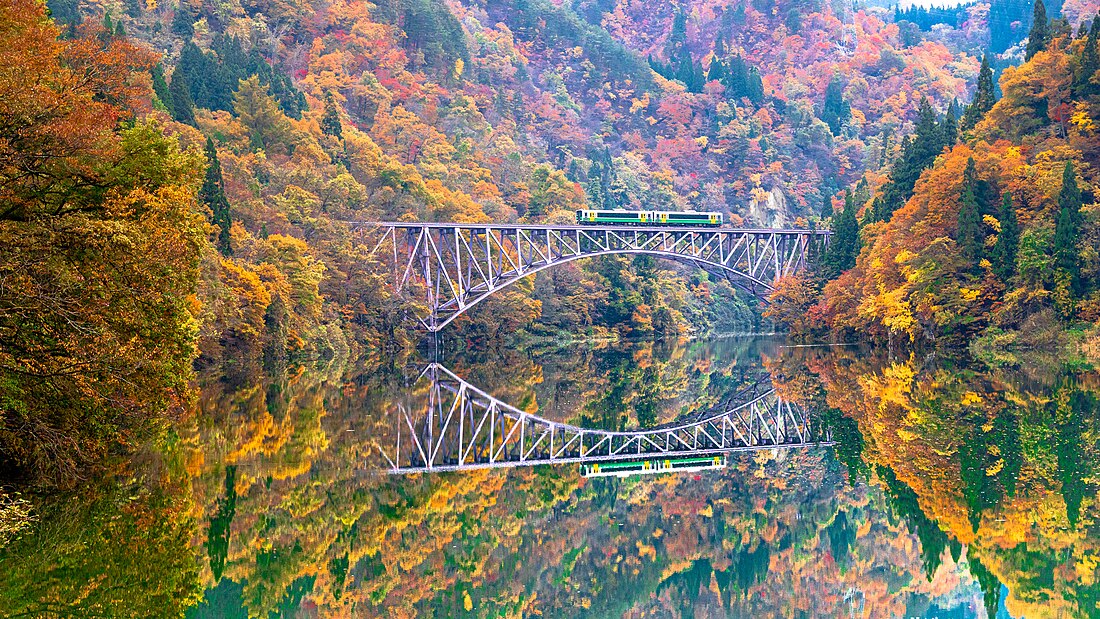Top Qs
Timeline
Chat
Perspective
Tadami Line
Railway line in Japan From Wikipedia, the free encyclopedia
Remove ads
The Tadami Line (只見線, Tadami-sen) is a 135-kilometre (84 mi) scenic railway line in Japan operated by East Japan Railway Company (JR East). It connects Aizu-Wakamatsu Station at Aizuwakamatsu in Fukushima Prefecture with Koide Station at Uonuma in Niigata Prefecture.[1]
The line opened in discontinuous stages between 1928 and 1971. Because of trouble financing rainstorm damage repairs, the line had no rail service between Aizu-Kawaguchi and Tadami station from July 2011 until October 2022.[2][3][4] During this time, a replacement bus operated between Aizu-Kawaguchi and Tadami.[5][6] Full service on the line resumed on 1 October 2022.
Remove ads
Services

All trains are local (all-stations) services, with approximately eight to nine trains in each direction per day. Only three round-trips operate over the entire line, and some seasonal trains operate through onto the line from the Ban'etsu West and Jōetsu lines. Due to the many curves on the line trains take over four hours to traverse its 135.2 km (84.0 mi) length.[7]
Station list
- All trains stop at every station.
- Trains can pass each other at stations marked "◇", "∨", "∧"; they cannot pass at those marked "|".
- All Aizu Line trains run through to Aizu-Wakamatsu Station.
Remove ads
History
Summarize
Perspective
Openings
The eastern section of the line from Aizu-Wakamatsu to Aizu-Yanaizu opened in 1928. The eastern section was extended to Aizu-Miyashita in 1941 and to Aizu-Kawaguchi in 1956. At that time, the Tagokura Dam was under construction and a light railway was built to link Aizu-Kawaguchi with the construction site in order to transport construction material. In 1963, after the dam was completed, the construction railway was upgraded and opened to Tadami as part of the eastern section.[5]
In the meantime, the western section of the line, from Koide to Oshirakawa, had opened in 1942. In 1971, the two sections were connected with the opening of the passenger only line between Oshirakawa and Tadami.[5]
Closures
Freight services ceased between 1980 and 1982.[citation needed]
Damage from heavy rain storms in July 2011 forced the section of the line between Aizu-Kawaguchi and Ōshirakawa to be closed. The section between Tadami and Ōshirakawa was reopened on 1 October 2012, but the restoration of the remaining section between Aizu-Kawaguchi and Tadami proved more problematic.[8] Eventually, JR East reached an agreement with Fukushima Prefecture under which the prefecture would buy the rail infrastructure and land while hiring out its operation to JR East.[9] After 11 years with a replacement bus service, the closed section resumed operations on 1 October 2022.[6]
Tagokura Station, located between Ōshirakawa and Tadami, was closed in 2013.[10] Kakinoki Station, between Irihirose and Ōshirakawa, was closed in 2015.[11] Both of these station closures were due to very low usage.
Rolling stock
- KiHa E120 - Since March 2020
- KiHa 110 series - Since July 2020[12]
Former
- KiHa 40 series - Until July 2020[12]
- KiHa 58 series
Gallery
- C11 289 between Aizu-Nishikata and Aizu-Hibara, November 1973
- C11 289 between Aizu-Miyashita and Aizu-Nishikata, November 1973
- KiHa E120, Aizu-Bange Station - Wakamiya Station, in March 2020
- KiHa 40, Aizu-Takada Station - Negishi Station, in May 2018
- KiHa 47 and 40, Oshirakawa Station, September 2012
- Minibus departure from Tadami Station, June 2014
- Tadamigawa Bridge No. 3
- Tadamigawa Bridge No. 4
- Tadamigawa Bridge No. 5
- Tadamigawa Bridge No. 8
- Tadamigawa Bridge No. 1 in winter
Remove ads
References
External links
Wikiwand - on
Seamless Wikipedia browsing. On steroids.
Remove ads













